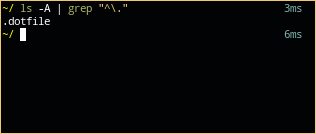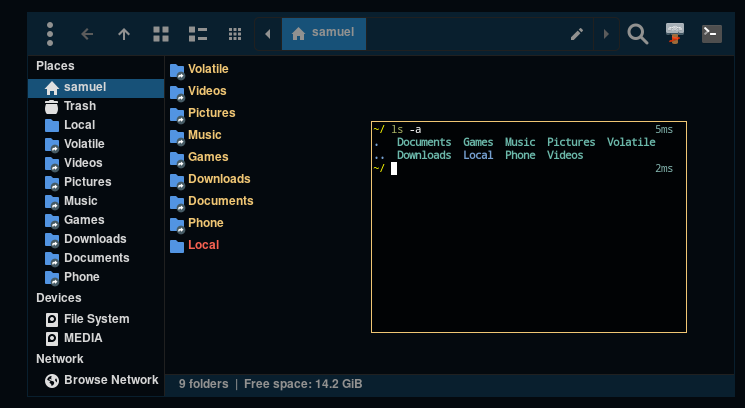Shameless plug: I am the author.
Golang puts shit specifically in
$HOME/go. Not even.go. Just plaingo.Why is it so difficult to follow industry standards
off the shelf go was too annoying for me
Nowadays I set GOENV_ROOT to an XDG location and use goenv instead.
100% agree and I also despise devs who do this on windows, instead of using %appdata% they’re using c:\users\username\.myappisimportantandtotallydeservesthisdir
I have to use a separate Documents folder for my actual documents lol
Here is a more concise way to achieve the same thing:
ls -ACd ~/.??*/ | sed -e "s#$HOME/##g"I think that can be boiled down to only
cd; echo .*/Maybe throw a
;cd -on the end if the change of directory is unwanted.ls -A | grep "^\."
I had to make a dummy
.dotfileto test because I don’t have hidden files in my home.
Shameless flex

Whoa I’m a stickler for getting as much as I can out but even I have .zshenv and some other too hard to figure out things in there. How’d you manage a total wipeout?
zsh is actually easy and it is detailed in the archwiki
You have to set
$ZDOTDIRin/etc/zsh/zshenvand iirc that was the only location that required root to edit.For the rest of stuff, here is how I fix steam for example and you can check the rest of my dotfiles for how I configured zsh and all of that.
Although I haven’t updated them, I still had a
.localdirectory back then, it was 1 week ago that I changed.localforLocaland that let to an issue with distrobox which I made a PR fixing it that’s still open though.That’s awesome!
ls VolatileIt’s empty lol, it’s a directory on tmpfs that i use to build programs and similar stuff to not be hammering my ssd with unnecessary writes.
I have
$XDG_CACHE_HOMEin tmp as well and I moved the mesa sharer caches to$XDG_STATE_HOMEas that’s really the only thing so far I’ve needed to preserve.tmpfs (…) to build programs (…) to not be hammering my ssd with unnecessary writes
Sounds useful. How did you setup the directory?
Running
dftells me “tmpfs” is mounted on /run. If I build in that that directory then would it be stored in RAM, or do I need to do something else?I have /tmp in my fstab with these mount options.
tmpfs /tmp tmpfs rw,noatime,size=20G 0 0And the rest of the setup is done in my zprofile
I think I should be able to get this working following your zprofile file. Thanks!
there’s no place like 127.0.0.1
there’s no place like XDG_CONFIG_HOME.
YOU’RE NOT MY MOM I’LL DO WHAT I WANT
vim now has an option to put the .vim folder in ~/.config; though I’m not sure if the default plugin/package & syntax folders can be set under ~/.local/share.
حق
deleted by creator
This would just further complicate things for me. It assumes that 1) the system even has a windowing system/desktop environment or 2) all the installed software is XDG-aware. Most of the time I’m fiddling with headless environments.
The spec doesn’t make those assumptions at all, idk where that’s coming from.
I have headless machines with XDG vars configured and ones without them. XDG compliant software works in either case, but I’m less likely to use a piece of software that clutters my $HOME.
Whatever happened to Linux being all about choice? Do you want that or not?
But what’s the difference? It’ll be in /home anyways and I heard BSD had some issues with something that could be XDG.
Better organization and backup / restore. For example if you want to restore config files but don’t want to move over the large “.local” folder, applications that write to $HOME will create diifculty.
Because, like /etc, you know there is a designated place for config files. It’s already set for you right there, and there is a standard for it.
/etc can’t be edited on immutable distros and usually apps store the editable config in /home/config and make the /etc one kind of read-only.
/etc can’t be edited on immutable distros
False on at least Fedora Atomic[1], NixOS[2] and openSUSE Aeon[3]…
Which ‘immutable’ distros are you referring to?
- On Fedora Atomic, changing
/etcis literally identical to how it goes any other distro; or at least 1-to-1 as on traditional Fedora. The bonus is that a pristine copy of the original/etcis kept inside a sub-directory of/usr. Furthermore, all changes compared to the pristine copy are kept track of. - On NixOS, changes have to be applied through
configuration.nix. Though, regardless, it’s effectively possible to edit and populate/etclike it is on other distros. - It’s explicitly mentioned that
/etcdoes not belong to the immutable base.
Fedora Atomic allowed it recently afaik. I’m always forgetting this. And NixOS is not immutable because of R/W FS.
No sorry, Fedora Atomic has allowed changes to
/etcsince at least 2019. Regarding NixOS, the consensus is that it’s an immutable distro. The immutability of/nix/store/suffices for this.Your notion on Fedora Atomic was false. So, what other ‘immutable’ distro did you have in mind when making that comment?
Please stop harassing me. And idk. I saw that issue but at this point I think it was just misinformation.
Thank you for your honesty! I only intend for the truth to prevail and/or to reach mutual understanding. So please don’t feel attacked. If somehow I came off as such, my apologies; that has never been my intent.
- On Fedora Atomic, changing
But what’s the difference?
I can only imagine someone asking this if they a) don’t use the terminal except if Stackexchange says they should and b) have yet to try and cleanup a system that’s acquired cruft over a few years. If you don’t care about it, then let me flip that around and ask why you care if people use XDG? The people who care about it are the people in the spaces that concern it.
Off the top of my head this matters because:
- it’s less clutter, especially if you’re browsing your system from terminal
- it’s a single, specified place for user specific configs, session cache, application assets, etc. Why wouldn’t such important foundational things required for running apps not be in a well defined specification? Why just dump it gracelessly in the user’s root folder outside of pure sloppy laziness?
- it makes uninstalling apps easier
- it makes maintenance easier
- it makes installing on new machines easier
It’ll be in /home anyways and I heard BSD had some issues with something that could be XDG.
🙄
Weird to me that you apparently think the only way of viewing files is in a terminal
It’s weird to me that you think I think that. I do primarily browse files by terminal, but not always. Before I got into heavy terminal use I was a power user of Nemo. In any case, dumping everything in /home does not make for a better gui file browsing experience, either
The implication seemed to be “if you don’t care exactly where all your files are you must not use terminal”. Which I still don’t get. Just about anyone who would even be in a community like this uses terminal a lot anyway.















